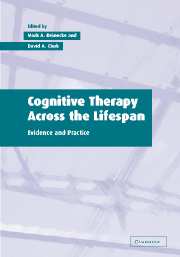Book contents
- Frontmatter
- Contents
- List of contributors
- Foreword
- 1 Cognitive therapy across the lifespan: conceptual horizons
- 2 Cognitive theory and therapy of depression
- 3 Cognitive theory and therapy of bipolar disorders
- 4 Regulation of emotion in generalized anxiety disorder
- 5 Cognitive theory and therapy of obsessions and compulsions
- 6 The cognitive model of panic
- 7 Treating obsessional problems using cognitive-behavioral therapy
- 8 Narcissistic personality disorder
- 9 Cognitive therapy and the self
- 10 Promoting cognitive change in posttraumatic stress disorder
- 11 Cognitive theory and therapy of social phobia
- 12 The cognitive model of bulimia nervosa
- 13 Cognitive therapy and schizophrenia
- 14 Cognitive-behavioral interventions for alcohol abuse and dependence
- 15 Cognitive approaches to understanding, preventing and treating child and adolescent depression
- 16 Cognitive-behavioral interventions in childhood anxiety disorders
- 17 Attention deficit/hyperactivity disorder
- 18 Cognitive-behavioral interventions for children with conduct problems
- 19 Processes of change in cognitive therapy
- 20 Cognitive therapy in the twenty-first century: current status and future directions
- Index
10 - Promoting cognitive change in posttraumatic stress disorder
Published online by Cambridge University Press: 05 July 2014
- Frontmatter
- Contents
- List of contributors
- Foreword
- 1 Cognitive therapy across the lifespan: conceptual horizons
- 2 Cognitive theory and therapy of depression
- 3 Cognitive theory and therapy of bipolar disorders
- 4 Regulation of emotion in generalized anxiety disorder
- 5 Cognitive theory and therapy of obsessions and compulsions
- 6 The cognitive model of panic
- 7 Treating obsessional problems using cognitive-behavioral therapy
- 8 Narcissistic personality disorder
- 9 Cognitive therapy and the self
- 10 Promoting cognitive change in posttraumatic stress disorder
- 11 Cognitive theory and therapy of social phobia
- 12 The cognitive model of bulimia nervosa
- 13 Cognitive therapy and schizophrenia
- 14 Cognitive-behavioral interventions for alcohol abuse and dependence
- 15 Cognitive approaches to understanding, preventing and treating child and adolescent depression
- 16 Cognitive-behavioral interventions in childhood anxiety disorders
- 17 Attention deficit/hyperactivity disorder
- 18 Cognitive-behavioral interventions for children with conduct problems
- 19 Processes of change in cognitive therapy
- 20 Cognitive therapy in the twenty-first century: current status and future directions
- Index
Summary
It has long been observed that traumatic experiences are often followed by a distinct pattern of distressing symptoms. Accounts of such reactions began to appear in the psychiatric literature with greater frequency after the Second World War, resulting in the inclusion of “gross stress reaction” in the first version of the American Psychiatric Association (APA) Diagnostic and Statistical Manual (DSM-I) in 1952. Although the DSM-I noted that exposure to extreme stress may trigger great psychological distress, it did not provide diagnostic criteria for the stress reaction. It was not until the third revision of the DSM(DSM-III; APA, 1980) that mental health experts first codified the pattern of posttrauma reactions as a distinct anxiety disorder, termed posttraumatic stress disorder (PTSD), and offered clear and specific diagnostic criteria.
A vast amount of research has been conducted on PTSD since its formal designation over 20 years ago. Although much of this research has been a theoretical, focusing on issues such as phenomenology, prevalence, and comorbidity, theories about the development and maintenance of PTSD have stimulated a number of studies investigating both the psychopathology and the treatment of the disorder. Among the most influential and fruitful models of PTSD are those offered by cognitive or information-processing theory and emotional-processing theory.
In this chapter we first review the diagnosis and prevalence of PTSD. Second, we review the history of the evolution of cognitive models of PTSD.
- Type
- Chapter
- Information
- Cognitive Therapy across the LifespanEvidence and Practice, pp. 231 - 257Publisher: Cambridge University PressPrint publication year: 2003

